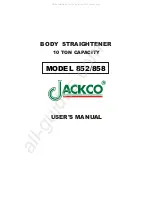
Waterlock NLPH
030427.03
5
ENGLISH
The two halves can be turned relative to each other as follows:
1 Unscrew the clamp
2 Turn the half of the housing to the desired position
3 Tighten the clamp sufficiently using a torque of 0.3 Nm
(0.22 ft-lb, 42 oz-in).
During operation, the waterlock will contain water. Its weight will
thus increase considerably, so fit the waterlock with the ty-raps® sup-
plied. The waterlock has slots in which the ty-raps® should be fitted.
2.3 Installing the transom exhaust connection
Fit the transom exhaust connection at such a position that with the
ship fully laden, the outlet is still at least 5 cm (2”) above the water-
line.
2.4 Exhaust pipe
In order to ensure the proper drainage of the coolant water injected
into the exhaust pipe, the pipe must be installed with a slope down-
ward over its whole length from the water injection point to the wa-
terlock.
During operation, the exhaust pipe will contain water. This will in-
crease its weight considerably, so support the exhaust pipe properly.
The exhaust pipe from waterlock to transom connection must be in-
stalled in such a way that:
- The highest point in the exhaust pipe should not be more than
150 cm (5 ft) above the underside of the waterlock.
- The length of the section between the waterlock and the highest
point, should not exceed 300 cm (10 ft).
2.5 Fitting the hose
To ease the fitting of the hose to the hose connector, use only water
and/or soap, NOT grease or products containing oil.
Fit each hose connection with 2 stainless steel 12 mm (1/2”) wide
hose clamps.
2.6 Sensor for temperature alarm
A sensor for a temperature alarm can be fitted in the exhaust pipe.
3
Installation Examples
Exhaust systems with a waterlock type NLPH, goose neck type NLPG
and a transom connection are shown on page 15.
Entry of water from the aft is almost completely prevented by the
extra height difference in the goose neck.
When the engine is stopped, any water which is still in the exhaust
pipe (between the highest point in the exhaust system and the ex-
haust silencer) will run back to the exhaust silencer.
To reduce the amount of this water as much as possible, the goose
neck should be fitted directly above the exhaust silencer, if possible
(see drawings 1 and 3).
When the goose neck is fitted directly to the transom (drawings 2
and 4), the maximum length of the exhaust pipe, between exhaust
silencer and the highest point, should be taken into account.
3.1 Prevention of syphoning (drawings 3 & 4)
If the water injection point ‘C’ is below, or less than 15 cm (6”) above
the waterline (also when the ship heels under sail), there is a risk that
when the engine is stopped, the coolant water will enter the engine
due to syphoning. This syphoning can be prevented in two ways:
By creating an air vent system in the coolant water hose between
engine block and water injection point ‘C’, by fitting an air vent
with air vent pipe, for example.
The air vent pipe can be connected to its own hull outlet (H) or
to the connection on the gooseneck intended for this, type NLPG
(G). See the manual for the NLPG, no. 030428.01 (Only NLPH40,
45, 50).
By fitting an air vent (with valve) in the coolant water hose be-
tween the engine block and water injection point ‘C’.
4
Maintenance
• Check all hose connections for gas and water leaks regularly.
• Before the winter lay-up, drain the waterlock. The waterlock has
two drain plugs for this purpose.


































